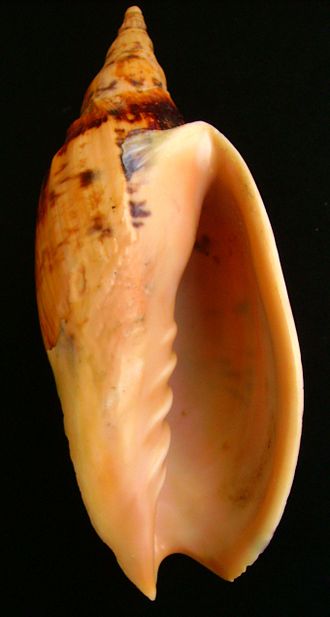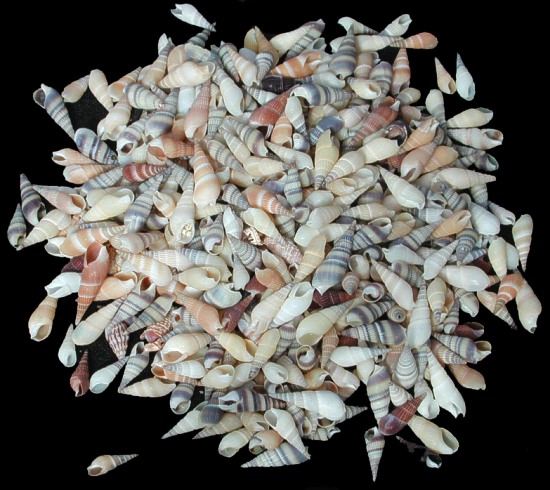Terebridae common name Auger Shells
Most of the Auger shells have long slender, glossy bodies. Some are thick and heavy; while others are light. their aperture (opening at the front end of the gastropod shell)and usually a rectangle, ending in a short, wide siphonal canal(the tube or gutter at the lower end of the aperture. The outer lip is thin and sharp edged and the columella (central pillar of the gastropod visible within the aperture).
All species are from warm or temperate seas living in intertidal zones. There they burrow and hide beneath rocks and coral. They feed on marine worms.
Terebridae, commonly referred to as auger shells or auger snails, is family of small to large predatory marine gastropods in the superfamily Conoidea.
The auger shells have high spired shells with many whorls, and the common name refers to the resemblance of their shells to rock drill-type drill bits.
There are over 400 known recent species worldwide.
A spire is a part of the coiled shell of mollusks. The spire consists of all of the whorls except for the body whorl. Each spire whorl represents a rotation of 360°.
A whorl is a single, complete 360° revolution or turn in the spiral or whorled growth of a mollusk shell.
Auger shells are typically shaped like slender screws. In that respect they share certain shell characters with the family Turritellidae, the turret shells.
One characteristic that distinguishes Terebridae from Turritellidae is the short anterior canal or notch in the aperture of the shell. Terebridae shells also tend to have characteristically flattened versus convex whorls, and they often have one or two plaits on the columella.
The aperture is an opening in certain kinds of mollusk shells: it is the main opening of the shell, where the head-foot part of the body of the animal emerges for locomotion and feeding.
Plaits are folds on the columella (also known as the pillar or axis) at the center of the shell. The columella (meaning little column) is the central structure around which the whorls of a coiled gastropod shell are coiled.
Augers are sand-dwelling carnivores which live in warmer waters. Most species have a venomous barb similar to that of the cone snails which is used to stun and immobilize prey. Their prey mainly consists of various marine worms.
Scientific classification
Domain: Eukaryota
Kingdom: Animalia
Phylum: Mollusca
Class: Gastropoda
Subclass: Caenogastropoda
Order: Neogastropoda
Superfamily: Conoidea
Family: Terebridae
Mörch, 1852
(REF:Mörch O. A. L. (1852). Catalogus conchyliorum quae reliquit D. Alphonso d'Arguirra et Gadea Comes de Yoldi, (1): 74 )(REF: Terryn, Y. (2007): A Collectors Guide to Recent Terebridae (Mollusca: Neogastropoda). 57 pp., 65 color plts. ConchBooks & NaturalArt, Hackenheim & Gen)(REF: Gofas, S. (2012). Terebridae. World Register of Marine Species [1])(REF: Fedosov, A. E.; Malcolm, G.; Terryn, Y.; Gorson, J.; Modica, M. V.; Holford, M.; Puillandre, N. (2020). Phylogenetic classification of the family Terebridae (Neogastropoda: Conoidea). Journal of Molluscan Studies, Volume 85, Issue 4)(REF: Bratcher T. & Cernohorsky W.O. (1987). Living terebras of the world. A monograph of the recent Terebridae of the world. American Malacologists, Melbourne, Florida & Burlington, Massachusetts)

The above shell picture shows five plaits on the columella, four strong and one weak.
(REF: Powell A W B, New Zealand Mollusca, William Collins Publishers Ltd, Auckland, New Zealand 1979 )

BABY AUGER SHELLS
X1-11
One quarter pound of Baby Auger Shells 1/2 to 3/4 inch...... OUT OF STOCK